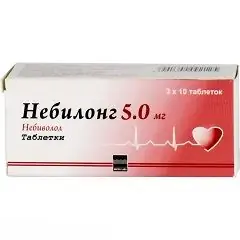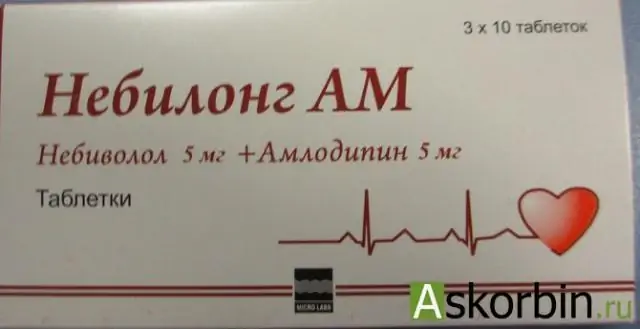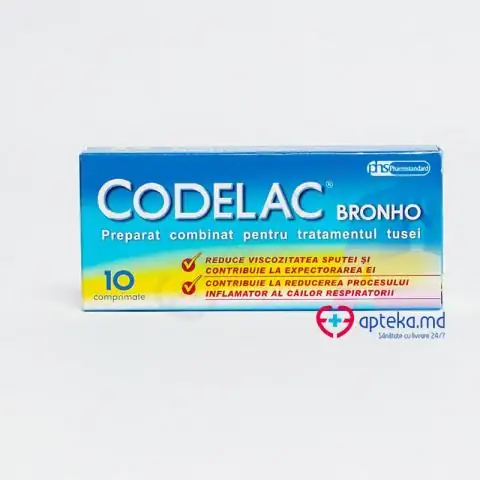- Author Rachel Wainwright [email protected].
- Public 2023-12-15 07:39.
- Last modified 2025-11-02 20:14.
Nebilong
Nebilong: instructions for use and reviews
- 1. Release form and composition
- 2. Pharmacological properties
- 3. Indications for use
- 4. Contraindications
- 5. Method of application and dosage
- 6. Side effects
- 7. Overdose
- 8. Special instructions
- 9. Application during pregnancy and lactation
- 10. In case of impaired renal function
- 11. For violations of liver function
- 12. Use in the elderly
- 13. Drug interactions
- 14. Analogs
- 15. Terms and conditions of storage
- 16. Terms of dispensing from pharmacies
- 17. Reviews
- 18. Price in pharmacies
Latin name: Nebilong
ATX code: C07AB12
Active ingredient: nebivolol (nebivololum)
Manufacturer: Micro Labs Limited (India)
Description and photo update: 2018-25-10
Prices in pharmacies: from 259 rubles.
Buy

Nebilong is a selective beta1-blocker.
Release form and composition
Dosage form Nebilong - tablets: flat-cylindrical, white or almost white, with a chamfer and a notch on one side (10 pcs. In a blister, in a cardboard box 1, 3 or 5 blisters; 15 pcs. In a blister, in a cardboard box 1, 4 or 7 blisters).
Composition of 1 tablet:
- active substance: nebivolol hydrochloride - 2.78 / 5.56 / 11.11 mg, which corresponds to the content of nebivolol - 2.5 / 5/10 mg;
- auxiliary components: microcrystalline cellulose, lactose monohydrate, betadex, sodium docusate, croscarmellose sodium, povidone, colloidal silicon dioxide, talc, magnesium stearate.
Pharmacological properties
Pharmacodynamics
Nebivolol is a cardioselective beta1-blocker with vasodilating properties. The drug blocks beta1-adrenergic receptors, transforming the production of endothelial relaxing factor. A decrease in blood pressure (BP) is achieved by reducing: total peripheral vascular resistance (OPSR), cardiac output, circulating blood volume, inhibition of the renin formation process, and a decrease in the sensitivity of beroreceptors.
The hypotensive effect of the drug is achieved, as a rule, within 1-2 weeks of taking it, and the pressure stabilization is achieved in 4 weeks. Nebilong lowers the heart rate both during exercise and at rest, lowers the oxygen demand of the heart muscle, improves diastolic filling, reduces the mass and myocardial mass index, and has a positive effect on the circadian rhythm of blood pressure. Does not affect lipid metabolism.
Pharmacokinetics
Nebivolol is rapidly absorbed from the gastrointestinal tract. The connection with plasma proteins is 98%. The drug crosses the blood-brain barrier. Nebivolol is metabolized in the liver. Nebivolol is excreted in the form of glucuronides in urine and feces.
Indications for use
- arterial hypertension;
- chronic heart failure (in combination with other drugs);
- ischemic heart disease (for the prevention of attacks of stable angina pectoris).
Contraindications
Absolute contraindications:
- severe liver dysfunction;
- acute heart failure;
- cardiogenic shock;
- decompensated chronic heart failure (requiring inotropic therapy);
- atrioventricular block II and III degree (without an artificial pacemaker);
- sick sinus syndrome, including sinoatrial block;
- pheochromocytoma (without the use of alpha-blockers);
- broncho-obstructive syndrome in bronchial asthma or chronic obstructive pulmonary disease;
- bronchial asthma and chronic obstructive pulmonary disease in severe form in history;
- metabolic acidosis;
- depression;
- bradycardia [heart rate (HR) ˂ 60 beats / min];
- arterial hypotension in severe degree (systolic blood pressure ˂ 90 mm Hg);
- severe peripheral atherosclerosis;
- lactose intolerance, lactase deficiency, glucose-galactose malabsorption;
- joint reception with floktaphenin, sultopride;
- age up to 18 years;
- increased sensitivity to the components of Nebilong or other beta-blockers.
Relative contraindications:
- liver dysfunction;
- renal failure;
- diabetes;
- hyperthyroidism;
- a history of bronchospasm episodes;
- a history of allergic diseases (due to the risk of increased sensitivity to allergens, aggravation of allergic reactions, decreased response to adrenaline);
- atrioventricular block I degree, Prinzmetal angina;
- psoriasis;
- chronic obstructive pulmonary disease;
- peripheral atherosclerosis;
- age over 65.
Instructions for use of Nebilong: method and dosage
According to the instructions, Nebilong is taken orally once a day at the same time, regardless of the meal. The tablets are swallowed whole with plenty of liquid.
Recommended dosage:
- arterial hypertension: 5 mg / day (if necessary, it is possible to increase the dose to 10 mg / day), the effect of the drug is observed after 1-2 weeks (in some cases up to 4 weeks). It is possible to use Nebilong both in monotherapy and as part of complex therapy;
- chronic heart failure: the dose of the drug should be increased gradually (at intervals of at least 2 weeks, depending on the patient's tolerance to the given dose), until the individual optimal maintenance is achieved. The initial dose is 1.25 mg / day, then it can be increased to 2.5-5 mg / day, and then to 10 mg / day (the maximum recommended dose). After taking the first dose of the drug, as well as after each subsequent increase in the dose, the patient should remain under the supervision of a physician for 2 hours. During the titration period, it is recommended to regularly monitor blood pressure and heart rate, as well as the severity of symptoms of chronic heart failure. In case of deterioration of the patient's condition during the titration period or the appearance of symptoms of drug intolerance, the dose of Nebilong should be reduced or discontinued (with pronounced rterial hypotension, worsening of the course of chronic heart failure with acute pulmonary edema, with the development of cardiogenic shock, symptomatic bradycardia, AV blockade).
Side effects
- nervous system: headache, dizziness, weakness, fatigue, paresthesia, depression, confusion, vivid dreams, insomnia, hallucinations, syncope, amnesia;
- Gastrointestinal tract (gastrointestinal tract): diarrhea, constipation, nausea, vomiting, flatulence, dyspepsia;
- cardiovascular system: acute heart failure, bradycardia, atrioventricular blockade, peripheral circulatory disorders, orthostatic hypotension, dyspnea, Raynaud's syndrome, cardiac arrhythmias, peripheral edema, cardialgia, worsening of chronic heart failure (especially during the titration period of the drug dose), pronounced lowering blood pressure;
- skin and subcutaneous tissues: itching, erythematous skin rash, hyperemia of the skin, alopecia, aggravation of the course of psoriasis, angioedema;
- respiratory system: bronchospasm;
- other: visual impairment, dry eyes, sexual dysfunction, photodermatosis, hyperhidrosis.
Overdose
Symptoms of a Nebilong overdose: bradycardia, marked decrease in blood pressure, severe intracardiac conduction disturbances, asystole, shock, respiratory arrest, loss of consciousness, bronchospasm, convulsions, coma, nausea, vomiting, cyanosis, hyperkalemia, hypoglycemia.
Treatment: recommended gastric lavage, intake of activated carbon.
Further symptomatic therapy in individual cases:
- a pronounced decrease in blood pressure: give the patient a horizontal position, raise his legs, if necessary, intravenous (IV) administration of fluid and vasopressors is possible;
- bradycardia: inject a single intravenous atropine in a dose of 0.5-2 mg. If necessary, the setting of a transvenous or intracardiac artificial pacemaker is possible;
- AV blockade (II - III degree): intravenous injection of beta-adrenergic agonists, in case of their ineffectiveness, an artificial pacemaker may be required;
- heart failure: recommended the introduction of cardiac glycosides, as well as diuretics, in the absence of an effect, dopamine, dobutamine or vasodilators are administered;
- bronchospasm: intravenous administration of beta2-adrenergic agonists;
- convulsions: intravenous diazepam;
- ventricular premature beats: the use of lidocaine is recommended (the introduction of class IA antiarrhythmic drugs is prohibited).
special instructions
Cancellation of the drug should be done gradually, over 10-14 days.
At the beginning of taking Nebilong, daily monitoring of blood pressure and heart rate is required. Elderly patients need to monitor kidney function every 4-5 months.
In patients with exertional angina, the selected dose of Nebilong should provide a resting heart rate of 55-60 beats / min, with a load of up to 110 beats / min.
Before using Nebilong, patients with psoriasis should carefully balance the expected benefits of the drug and the possible risk of exacerbation of the course of psoriasis.
When taking beta-blockers, it is possible to reduce the production of tear fluid, which should be taken into account when using contact lenses.
In the event of an impending surgical operation, it is necessary to inform the surgeon and anesthesiologist about the appointment of Nebilong.
Patients with diabetes should be aware that nebivolol, although it does not affect blood glucose concentration, may mask some symptoms of hypoglycemia, such as tachycardia.
In patients with overactive thyroid gland, Nebilong eliminates tachycardia.
Smoking reduces the effectiveness of beta-blockers.
Influence on the ability to drive vehicles and complex mechanisms
During the period of taking Nebilong, care should be taken when driving vehicles, as well as other complex mechanisms that require the speed of psychomotor reactions.
Application during pregnancy and lactation
The use of Nebilong during pregnancy can cause bradycardia, arterial hypotension, hypoglycemia and respiratory paralysis in a newborn, and is possible only for health reasons, in the case when the expected benefit to the mother outweighs the possible risk to the fetus.
Stop taking Nebilong 48-72 hours before delivery. If this is not possible, the newborn should be closely monitored for the first 48-72 hours after delivery.
If necessary, the use of the drug during lactation, breastfeeding should be discontinued.
With impaired renal function
Treatment of arterial hypertension in patients with renal insufficiency should begin with a dose of 2.5 mg / day, then it may be increased to 5 mg / day. In severe renal impairment (creatinine clearance ˂ 20 ml / min), the maximum daily dose should not exceed 10 mg.
For violations of liver function
The appointment of Nebilong is contraindicated for severe liver dysfunction. Patients with liver disease in the treatment of arterial hypertension should not exceed the maximum daily dose of the drug - 10 mg.
Use in the elderly
Patients over the age of 65 should start treatment with a dose of 2.5 mg / day, then it may be increased to 5 mg / day.
Drug interactions
Pharmacological interaction:
- amiodarone, dronedarone, procainamide, quinidine: concomitant administration with nebivolol is contraindicated due to the risk of ventricular arrhythmia caused by sotalol;
- acetylsalicylic acid, read NSAIDs (non-steroidal anti-inflammatory drugs): can be used together with nebivolol;
- floctafenin: Nebilong is able to weaken the compensatory mechanisms of the cardiovascular system in shock or arterial hypotension caused by taking floctaphenin;
- sultopride: the risk of ventricular arrhythmias increases, especially of the "pirouette" type;
- blockers of slow calcium channels (BMCC) (verapamil, diltiazem): negative effects on myocardial contractility and AV conduction. Intravenous verapamil is contraindicated for nebivolol therapy;
- antihypertensive drugs, nitroglycerin and BMCC: risk of severe arterial hypotension, especially when using prazosin;
- antiarrhythmic drugs: risk of bradycardia and cardiodepressant action;
- amiodarone: risk of atrioventricular block;
- cardiac glycosides: no increase or decrease in AV conduction was detected;
- drugs for general anesthesia: it is possible to suppress reflex tachycardia and increase the risk of developing arterial hypotension;
- gestagens, estrogens, glucocorticosteroids: reduce the antihypertensive effect of beta-blockers;
- tricyclic antidepressants, barbiturates, phenothiazine ethanol derivatives, anxiolytics, hypnotics: may enhance the antihypertensive effect of nebivolol;
- allergens and extracts of allergens (with immunotherapy and skin tests): increase the risk of severe systemic allergic reactions and anaphylaxis;
- iodine and X-ray contrast agents for intravenous administration: increase the risk of anaphylactic reactions.
Pharmacokinetic interaction:
- digoxin, ranitidine ethanol, warfarin, furosemide, hydrochlorothiazide: no interaction established;
- nicardipine: the concentration of drugs in the blood plasma increases, but this has no clinical significance;
- serotonin reuptake inhibitors, as well as biotransforming drugs with the participation of the isoenzyme CYP2D6: slow down the metabolism of nebivolol, which can lead to bradycardia;
- cimetidine: increases the concentration of nebivolol in blood plasma;
- rifampicin: increases the metabolism of nebivolol;
- insulin, hypoglycemic drugs: symptoms of hypoglycemia such as tremors, tachycardia can be masked.
Analogs
Nebilong's analogs are Bivotenz, Binelol, Nebivator, Nebivolol, Nebikor, Adipharm, Nebilet, Nevotenz, OD-neb, etc.
Terms and conditions of storage
Store in a dry place away from light. At a temperature not higher than 25 ° C. Keep out of the reach of children.
Shelf life is 3 years.
Terms of dispensing from pharmacies
Dispensed by prescription.
Reviews about Nebilong
Reviews of Nebilong among patients and doctors are mostly positive. The drug helps to quickly bring the patient's blood pressure back to normal and avoid hypertensive crises.
Price for Nebilong in pharmacies
The approximate price for Nebilong is for 5 mg tablets: 30 pcs. in the package - 370 rubles, for 50 pcs. - 603 rubles; for 10 mg tablets 30 pcs. in the package - 625 rubles.
Nebilong: prices in online pharmacies
|
Drug name Price Pharmacy |
|
Nebilong 5 mg tablets 30 pcs. 259 r Buy |
|
Nebilong 2.5 mg tablets 30 pcs. RUB 319 Buy |
|
Nebilong tablets 2.5mg 30 pcs. 324 r Buy |
|
Nebilong 5mg tablets 30 pcs. 348 r Buy |
|
Nebilong 5 mg tablets 50 pcs. 382 r Buy |
|
Nebilong AM 5 mg + 5 mg tablets 30 pcs. 465 RUB Buy |
|
Nebilong 10 mg tablets 30 pcs. RUB 499 Buy |
|
Nebilong N 12.5 mg + 5 mg tablets 30 pcs. RUB 524 Buy |
|
Nebilong AM tablets 5mg + 5mg 30 pcs. 532 RUB Buy |
|
Nebilong 10mg tablets 30 pcs. RUB 610 Buy |
|
Nebilong n tab. 12.5mg + 5mg No. 30 RUB 610 Buy |
|
Nebilong tablets 5mg 50 pcs. 654 r Buy |
| See all offers from pharmacies |

Anna Kozlova Medical journalist About the author
Education: Rostov State Medical University, specialty "General Medicine".
Information about the drug is generalized, provided for informational purposes only and does not replace the official instructions. Self-medication is hazardous to health!






